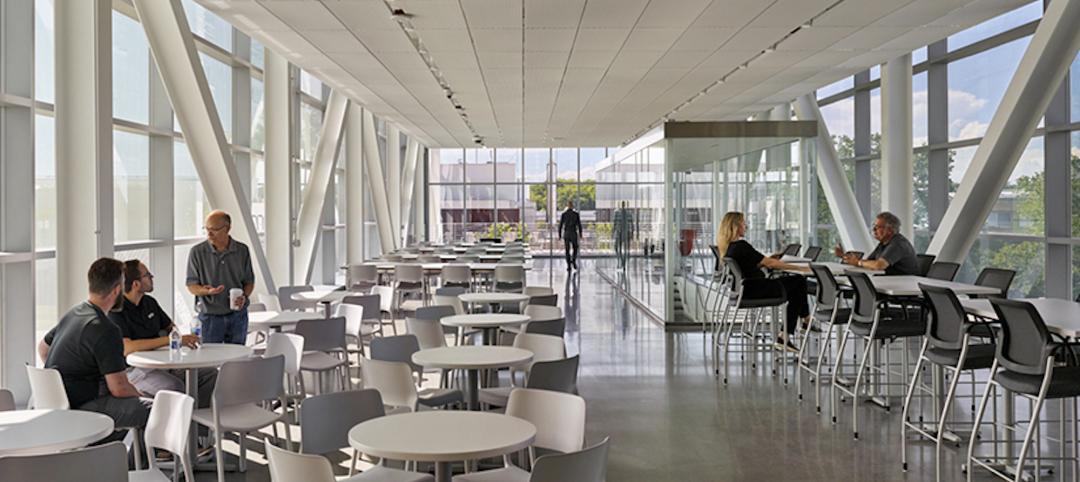When your HVAC system was new, it was designed to keep the indoor environment comfortable, functional, and safe. Over time, that system can drift out of alignment, leading to wasted resources, excessive energy consumption, and reduced occupant comfort.
Heating, ventilation, and air conditioning accounts for approximately 40% of the energy usage in an average commercial building, making it vital to conduct regular maintenance and keep these systems running efficiently.
To keep your building systems operating at peak performance, let’s examine the five most commonplace HVAC problems and potential solutions.
1. Incorrect Building Pressurization
When building pressurization is out of whack, you may notice doors slamming or hanging open, hot or cold spots, excessive humidity, or contamination of indoor spaces by outside debris such as dirt or leaves.
Most facilities need to maintain a slightly positive indoor air pressure, where more air is being taken into the building than taken out. If your building is not pressurized correctly, your HVAC system works harder to maintain heating and cooling, wasting energy and running up your utility bill.
To fix pressure issues, check for failed sensors, ensure proper sensor calibration, verify that outside air dampers and exhaust fans are not in override settings, and inspect duct work for leaks or damage.

2. Inadequate Use of Setbacks
Most facility managers are familiar with using sensors or scheduled setbacks to turn lights and equipment off when a space is not in use, but the same approach can be taken with HVAC to save you money by reducing system run time when the building is unoccupied.
When a space is unoccupied, your HVAC system should operate at reduced heating (winter) and cooling (summer) requirements. The system can then be scheduled to return to occupancy setpoints before people enter the building, ensuring the indoor environment is an appropriate temperature when occupied. These more relaxed setpoints allow for higher energy efficiency year-round.
Check your building and equipment design documents as a starting point for unoccupied versus occupied settings, then adjust through trial and error until you have the right settings.
3. Forgotten Overrides
When building occupants complain about being hot or cold, facility and maintenance staff sometimes input overrides into the HVAC system to temporarily resolve the issue. While this might fix the immediate problem, it might prevent your team from identifying and correcting the underlying issue that led to the complaint.
If these “fixes” become permanent, they can also lead to inefficiency and wasted energy. Our team worked with a middle school whose HVAC system was cooling the facility as if it was fully occupied in the middle of summer when most people were not using the space – a situation caused by overrides that were left on and forgotten. We worked closely with the school to correct the building systems so that they operated as intended, resulting in moving from an Energy Star score of 1 to 34 in just seven months.
To fix excessive overrides, reset your HVAC system to the original design settings. Regularly check the system and correct overrides to ensure the system operates as intended.
You can also work to create a culture of energy efficiency by tracking your utility bills and educating colleagues about the impact they have on energy consumption. This approach takes more effort, but will reap long-term rewards by reducing complaints and improving compliance with energy efficiency initiatives.
4. Excessive Ventilation
During the COVID-19 pandemic, many organizations increased outside air ventilation to improve air flow and exchange to reduce the spread of the virus. While increased ventilation does help with indoor air quality, many organizations overcorrected and paid the price in excessive heating and cooling costs.
Make sure to set your outside air ventilation to the standard and original design intent, which is already calibrated to provide a safe indoor environment.
5. Failed Sensors
Temperature, humidity, and pressure sensors are vital for peak HVAC system performance, but these sensors often fail as systems and equipment age.
If you notice a sensor value that has not changed for days or weeks, the sensor is probably faulty, leading to wasted energy and reduced performance.
You can correct failed and faulty sensors by recalibrating sensors, temperature probes, and dampers.
The Final Word
We’ve offered some general problems and potential solutions, but the best way to find out specific solutions to recurring HVAC issues is to conduct a focused retro-commissioning project.
Retro-commissioning is like a tune up for your building systems, safeguarding the long-term health of your infrastructure. And retro-commissioning often has a high return on investment, with a payback period of less than two years.
Many utilities offer incentive programs for good energy management and energy reduction practices, including retro-commissioning, where they will subsidize the cost of the study or provide rebates for successfully reducing energy usage. Make sure you check with your local utility before proceeding with a retro-commissioning project so you can take advantage of these financing options.
When it comes to HVAC systems, maintenance and monitoring are the key to success. A retro-commissioning approach will get you on the right track by providing a regular inspection of your equipment, monitoring energy usage, and updating the system as needed when it reaches the end of its useful life.
Connor Donovan, Engineer at HEAPY, and Tyler Guy, formerly with the firm, now Critical Facility Engineer at Facebook, contributed to this article.
Related Stories
Energy Efficiency | Dec 6, 2022
Washington state’s Building Code Council mandates heat pumps in all new residential construction
The Washington State Building Code Council has voted to require heat pumps for all new residential construction starting in July 2023. The new mandate has drawn criticism over concerns that it will add costs to housing construction, especially given current supply chain challenges for heat pumps.
75 Top Building Products | Nov 30, 2022
75 top building products for 2022
Each year, the Building Design+Construction editorial team evaluates the vast universe of new and updated products, materials, and systems for the U.S. building design and construction market. The best-of-the-best products make up our annual 75 Top Products report.
K-12 Schools | Nov 30, 2022
School districts are prioritizing federal funds for air filtration, HVAC upgrades
U.S. school districts are widely planning to use funds from last year’s American Rescue Plan (ARP) to upgrade or improve air filtration and heating/cooling systems, according to a report from the Center for Green Schools at the U.S. Green Building Council. The report, “School Facilities Funding in the Pandemic,” says air filtration and HVAC upgrades are the top facility improvement choice for the 5,004 school districts included in the analysis.
Engineers | Nov 10, 2022
U.S. engineering firms cash in on a volatile, expanding market
New practices and markets drive growth for U.S. engineering and engineering-architecture firms. And firms are getting serious about reducing projects’ carbon footprint.
Building Materials | Nov 2, 2022
Design for Freedom: Ending slavery and child labor in the global building materials sector
Sharon Prince, Founder and CEO of Grace Farms and Design for Freedom, discusses DFF's report on slavery and enforced child labor in building products and materials.
BAS and Security | Oct 19, 2022
The biggest cybersecurity threats in commercial real estate, and how to mitigate them
Coleman Wolf, Senior Security Systems Consultant with global engineering firm ESD, outlines the top-three cybersecurity threats to commercial and institutional building owners and property managers, and offers advice on how to deter and defend against hackers.
Multifamily Housing | Sep 15, 2022
Heat Pumps in Multifamily Projects
RMI's Lacey Tan gives the basics of heat pumps and how they can reduce energy costs and carbon emissions in apartment projects.
Building Materials | Aug 3, 2022
Shawmut CEO Les Hiscoe on coping with a shaky supply chain in construction
BD+C's John Caulfield interviews Les Hiscoe, CEO of Shawmut Design and Construction, about how his firm keeps projects on schedule and budget in the face of shortages, delays, and price volatility.
Multifamily Housing | Jul 26, 2022
All-electric buildings – great! But where's all that energy going to be stored?
There's a call for all-electric buildings, but can we generate and store enough electricity to meet that need?
Building Materials | Jun 20, 2022
Early-stage procurement: The next evolution of the construction supply chain
Austin Commercial’s Jason Earnhardt explains why supply chain issues for the construction industry are not going to go away and how developers and owners can get ahead of project roadblocks.

















